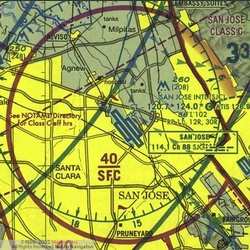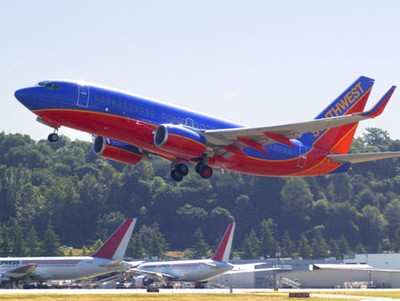Problems Arise Every Time The Wind Changes
 Airlines flying out of
Norman Mineta International Airport want the city of San Jose, CA
to make a commitment it won't allow developers to build above a
certain height downtown and west of downtown.
Airlines flying out of
Norman Mineta International Airport want the city of San Jose, CA
to make a commitment it won't allow developers to build above a
certain height downtown and west of downtown.
Usually, aircraft taking off from SJC do so to the north, where
there is plenty of building clearance. However, there are times
when wind conditions force take offs to the south, over downtown
San Jose.
For two-engine jets, FAA rules require planes taking off to have
clear emergency routes in the event of an engine failure. Some
airlines say they are having to reduce weight to accommodate this
rule, and are doing so by limiting the number of passengers thus
cutting into revenues and profit margins.
Those that carry the heaviest fuel loads, cross-country and
overseas flights, are most susceptible to profit loss.
If no guarantee is given, the airlines are threatening to take
their long-distance business elsewhere. Some of the airlines
serving SJC include Alaska Airlines, Southwest, Continental, Delta,
Frontier and Jet Blue among others.
Developer Mike Kriozere is in the middle of a condo towers
project downtown. He found a way to eliminate 10 feet off the
towers to meet new height limits proposed by the airport without
sacrificing a single floor. Not quite good enough, said San Jose
city planners and demanded another 4 feet.
Kriozere is now making his own demands. He has agreed to take a
floor off the top, at a loss of 20 condos, if the city will pick up
the tab for a cool $1.3 million. That's the amount Kriozere says
will have to be deducted from the $28.6 million pricetag he and the
city originally agreed upon for the 1.5-acre site.
The San Jose City Council will be asked to develop a policy on
how to deal with the FAA's "one-engine inoperative" requirement.
Should the lower height standard be adopted in certain areas of the
city, or should the current height limit be maintained?
The meeting to discuss the issue is set for August to give
business owners and groups time to make their opinions known as
well the verdict of a consultant hired by the airport to assess the
situation, according to the San Jose Mercury News.
The issue has turned into a case of airport economics versus
developer business interests. And no one, it seems, can agree on
the best way to solve the problem, but all seem to acknowledge the
issue is one of economics, not safety.
"A plane is not allowed to taxi from the terminal if there's a
possibility of it crashing into a building," said Joe Horwedel, San
Jose's director of planning. "The question is, `What type of
service do we want to have?'"
 Aviation Director Bill Sherry
said without a commitment to a revised height limit, the airport
"simply won't be able to attract long-haul flights to Tokyo, Dublin
and London. Even current flights to East Coast cities New York,
Atlanta, Boston, and Newark, NJ could be threatened, as well as
Hawaii and Mexico," he said.
Aviation Director Bill Sherry
said without a commitment to a revised height limit, the airport
"simply won't be able to attract long-haul flights to Tokyo, Dublin
and London. Even current flights to East Coast cities New York,
Atlanta, Boston, and Newark, NJ could be threatened, as well as
Hawaii and Mexico," he said.
"The city spent $100 million on runways and taxiways just for
this purpose," Sherry said about the airport's Phase 1 expansion to
handle long-haul flights. "This is a global city that is engaged in
a global economy. We need an unrestricted, vibrant airport."
Several developers have acquiesced to the proposed height limits
and have reduced their projects, rather than continue fighting the
two year-old battle. Kevin Sauser, an architect for the proposed 1
S. Market condominium project, reluctantly removed two floors from
a 22-floor residential tower to accommodate the airlines.
Some are still searching for a compromise. Adobe Systems paid
$25 million for 5.5 acres near downtown last year and have been
researching ways to allow the software maker to develop all one
million square feet of the San Jose Water Co. Property that was
purchased recently. They think they've found a solution: Move
flights 12 to 13 degrees to the west.
Developer Dan Hudson, of Hudson Properties, envisioned a high
rise when he bought his two-acre property on Stockton Avenue in
2004. Under the proposed restrictions, however, high-rises in his
entire neighborhood would have to be reduced from 208 feet to about
105 feet.
"This will have a huge fiscal impact on the city's ability to
generate revenues from property taxes, from fees from construction,
from people living there and shopping downtown," he said.
Paul Krutko, the city's economic development director, estimates
the loss of one international flight could cost the city "as much
as $24 million in economic impact."
Hudson disagrees.
"That economic impact has been massively minimized by the
airport and ... Krutko," he said.
"We have a significant number of the most important companies in
the United States within three and six miles of the airport, who
want intercontinental and international flights," Krutko said.
"They are not interested in flying to Chicago to go to Japan.
They'll just go north to SFO."
Scott Knies, head of the San Jose Downtown Association, says
"Don't get me wrong, the airport is vitally important. But let's
not toss out 20 years of sound planning just to make it easier to
recruit airlines."

Horwedel believes compromise is possible, but the
Diridon-Midtown area would have to change, he said. Instead of
20-story buildings, there would be10-story buildings that could be
stretched longer and be rectangular instead of square-shaped.
"With minor restrictions over the building heights in the
downtown area, we can still have a very vibrant, dense downtown,"
Horwedel said.
Craig Aldinger, flight operations engineer for Southwest
Airlines, said, "We know we have to be neighbors... But it would be
nice if living together we could come up with a compromise."
 Aero-News: Quote of the Day (12.07.25)
Aero-News: Quote of the Day (12.07.25) ANN's Daily Aero-Linx (12.07.25)
ANN's Daily Aero-Linx (12.07.25) NTSB Final Report: Lafferty Jack Sea Rey
NTSB Final Report: Lafferty Jack Sea Rey Classic Aero-TV: The B29 SuperFortress Doc - History in Flight
Classic Aero-TV: The B29 SuperFortress Doc - History in Flight Airborne 12.08.25: Samaritans Purse Hijack, FAA Med Relief, China Rocket Fail
Airborne 12.08.25: Samaritans Purse Hijack, FAA Med Relief, China Rocket Fail





